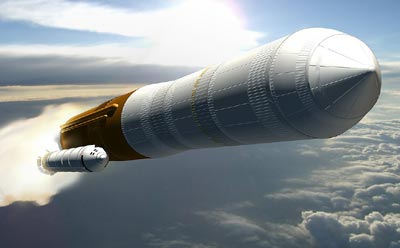The dangers of a rocket to nowhereby Lou Friedman
|
| Why does it seem like we can never get a rocket policy for civil space exploration right? |
I just read an interesting item about this in John Logsdon’s new book, John Kennedy and the Race to the Moon (see “Review: John F. Kennedy and the Race to the Moon”, The Space Review, February 28, 2011). Kennedy sent Nikita Khrushchev a congratulatory note on the launch of Venera-1, the first interplanetary mission. At the time, those considering space policy in the US considered that mission to be a demonstration of Soviet capability to orbit a nuclear warhead over Earth and de-orbit it at will, aimed at the US. They specifically noted that the Venus mission, launched on a powerful Russian rocket with large payload, began by orbiting Earth before applying a propulsive maneuver to take it out of orbit on its interplanetary path. Maybe that is why planetary exploration became part of a space race that was focused on nearer objectives.
Russia has maintained its access to space, cheaply and reliably, by never deviating from the military rockets that launched the space age. Other countries, with much smaller space programs and space industries, also have clearer development paths than does the US—not necessarily smoother ones, but clearer ones, such as the Ariane series in Europe and the H series in Japan. China also seems to be following step-by-step development of their Long March family of rockets. But the US flails: starting, stopping, debating, re-starting, and so on. And our Congress, ever searching for more pork, now refuses to use what we already have in favor of building something we don’t need.
Mark Matthews, writing for the Orlando Sentinel, recently made an important observation: the Congressional “Senate Launch System” (as detractors of what is officially known as the Space Launch System call it) is being built to test a new crew capsule but will likely never get used for anything else. He also used the term “rocket to nowhere”—a phrase for which I have some parental pride. The US will spend billions only to have to begin again from scratch if it really wants to go anywhere. From a timing point of view, that is fine. There are no missions that need heavy lift before 2020, but the money waste may set space exploration back further than that. Matthews’ piece is notable because it comes from Florida, one of the states with vested interest in the SLS.
I have rationalized this by saying it is only wasted money and, at least, it is wasted on good people with good jobs. That is the state of human space exploration. Robotic exploration has allowed us to extend human presence into the solar system. But now that is threatened, too, by the same old bugaboo: lack of affordable launches, plus the wasteful allocation of limited funds to the SLS.
| Human space exploration is dead in the water. NASA is trying hard to make lemonade from the Congressional lemons, but the ingredients are just too sour. |
Space science mission planners have recently been informed about big increases in the costs for the Atlas 5, costs that will lead to fewer missions. Repeating past mistakes, the government phased out use of the lower-cost Delta 2 on the promise of future launch vehicles. I completely agree with Alan Stern on the promise of the Falcon Heavy being good for space science (see “A new rocket for science”, The Space Review, May 16, 2011), but space science, and particularly planetary exploration, has learned many sad lessons relying on a launch vehicle not yet built.
Human space exploration is dead in the water. The unintended consequence of the misapplied funds for the SLS is that it will not assist human exploration and will inhibit robotic exploration. NASA is trying hard to make lemonade from the Congressional lemons, but the ingredients are just too sour. No one in politics (Administration or Congress) seems to care even though the public does. In 1980 when we had a similar situation (popular program, but weak political support) we formed The Planetary Society for grassroots action. I urge my colleagues in the space community to take grassroots action now: urge Congress to reconsider their course and reset our human mission plans.
